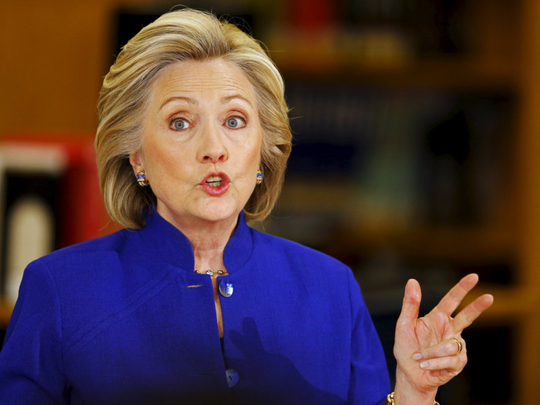
Have the questions swirling around the finances of the Clinton Foundation damaged Hillary Clinton’s brand? Many observers seem to think so. That word — “brand” — keeps popping up. Yet polls show that voters continue to lean her way.
When pundits express surprise at Hillary’s staying power, they are misunderstanding how brands work. Once we see what it actually means to have a brand, we will see why a rational Hillary supporter would be reluctant to switch.
To start with, why do brands matter? Consider a consumer who goes into the pharmacy to buy toothpaste. She wants to buy her favourite brand. She finds it on the shelf, pays her money and leaves. Chances are that her favourite brand was not the lowest priced among the various available toothpastes. It might not even have been the most effective at cleaning teeth. But it was the brand she was familiar with.
According to the theory of trademarks, the full price one pays for goods is the sum of the price in money and the search costs. The search costs are those associated with locating and evaluating the goods. If the brand of toothpaste if familiar, finding it is easy. The consumer recognises the package on the shelf. Similarly, the evaluation is easy. The consumer already knows the qualities of the toothpaste she prefers. As a consequence, her search costs are low, meaning that the owner of the brand can charge a higher price in money.
Suppose the consumer has become unhappy with her preferred toothpaste for some reason, or can’t find it on the shelf. Now she has to invest more resources in deciding which one to buy instead. This necessity will have the effect of reducing the price she is willing to pay in money. She not only has to expend resources but also has to be compensated for the risk that she won’t like the new toothpaste as much as the old one.
At the same time, the model provides an incentive for new entrants to the market to reduce the price of their toothpaste, in the hope that at a lower price, the consumer will be willing to give the new brand a try, notwithstanding the higher search costs. But some brand preferences are difficult to shake, even when competitors are able to point out the advantages of their product.
So here is the key, if paradoxical, point: A consumer doesn’t prefer a brand because it is better than the others. She prefers a brand because it is familiar. She knows the brand she wants possesses certain consistent qualities. She does not know the qualities of other brands, and, because searching is costly, may be unwilling to invest the necessary resources to find out. As long as her brand maintains its quality and does not raise the price too high, her rational choice is not to switch.
Reasons for voter not to switch
Now, let’s apply the model to electoral politics. Suppose that our consumer is a voter. She begins with a strong preference for Hillary Clinton; that is, Hillary is her favourite brand. Then questions are raised about certain aspects of her favourite brand. There are nevertheless strong and rational reasons for the voter not to switch. Let’s again consider the consumer.
First, the questions that are raised may not go to the qualities of the preferred brand that the consumer cares about. Suppose, for example, that she learns that her favourite brand of tuna isn’t “dolphin safe.”
If dolphins do not particularly interest her, she might well decide that the costs of switching are too great. Why invest time and energy in considering alternative brands if her preferred tuna still has the taste and texture she likes, and will therefore make a satisfying meal?
Second, even if the questions raised about her preferred brand do involve qualities of the product that matter to her, the consumer may nevertheless decide not to take the risk of choosing another brand. Her favourite toothpaste or her favourite tuna, whatever its flaws, might still seem preferable to the alternatives. The consumer has to price into her decision not only the costs of search but also the risks of selecting the wrong brand.
This, of course, is where the analogy breaks down. With toothpaste or tuna, the cost of trying a new brand is small. If the feared risks materialise — bad at cleaning teeth, bad taste – the buyer can throw the product in the trash and go back to the store. In politics, the potential cost of choosing wrongly is much greater.
Thus it is entirely rational that voters with strong preferences will be reluctant to switch brands. And let’s not forget: Even a damaged brand can be rehabilitated, provided it retains sufficient goodwill in the marketplace. After the Tylenol poisonings in 1982, analysts thought the Johnson & Johnson brand was dead: “Marketers predicted that the Tylenol brand, which accounted for 17 per cent of the company’s net income in 1981, would never recover from the sabotage.” The doomsayers were wrong. The company ran a fully transparent investigation, featuring frequent and confident updates from the then-chairman, James Burke. The stock rebounded strongly. So did Tylenol’s market share.
Polling data suggests that Hillary doesn’t face nearly the battle for her brand that Tylenol did. If she maintains sufficient goodwill in the electoral marketplace — or if her competitors seem too risky — we can predict that those who strongly preferred her before the questions about the foundation prefer her still. If voters behave like consumers, it will likely take a lot more to get them to switch brands.
Plainly, the producer cannot capture the entire value of the saved search costs, or he may lose the consumer to a competing brand whose lower price plus higher search costs are smaller than the preferred brand’s higher price plus lower search costs.
—Washington Post







